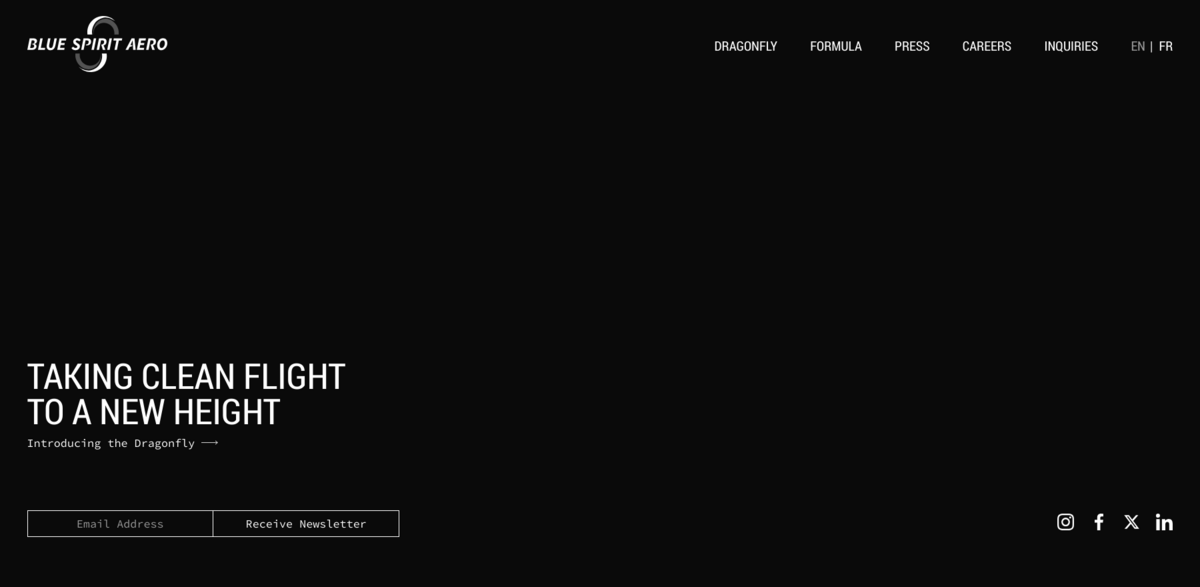What is the Blue Spirit Aero Project?
Blue Spirit Aero (BSA) is taking clean flight to a whole new height with its groundbreaking Dragonfly family of hydrogen-electric aircraft. This project is all about transforming light aviation by harnessing hydrogen fuel cell technology to create sustainable, efficient, and quiet flights. Imagine planes powered by clean hydrogen fuel cells, producing zero emissions and offering a smooth, whisper-quiet ride. The Dragonfly lineup combines comfort, sustainability, and performance, making it a true pioneer in the future of aviation. Each aircraft features an innovative architecture based on Electric Distributed Propulsion, which means short takeoff and landing distances (STOL) and spacious cabins designed for people or freight. The propulsion pods—each including a propeller, electric motor, fuel cell, and hydrogen tank—are cleverly distributed along the wings, enhancing safety and efficiency. Plus, by separating the hydrogen system from the cockpit and increasing the number of propulsion units, BSA boosts redundancy and safety. It’s a fresh take on flying, literally zero emission, with water as the only by-product.
Main Benefits and Key Figures
So, what makes the Dragonfly stand out? Here’s a quick rundown of the key specs and benefits that really highlight its potential:
- Ground Takeoff Distance: less than 1150 ft
- Service Ceiling Altitude: 10,000 ft
- Climb Rate: over 800 ft/min
- Stall Speed (Flaps Extended): 60 knots
- Cruise Speed: 125 knots
- Max Range: 375 to 540 nautical miles depending on model
- Wingspan: 13 meters
- Length: 7.5 meters
- Cabin Dimensions: 1.5 m wide, 2.5 m long, 1.5 m high
- Maximum Takeoff Mass (MTOM): 1850 kg
- Seats: 4
- Useful Payload: over 370 kg
- Fuel Mass vs MTOM: less than 2%
- Power Source: Hydrogen Fuel Cells
- Pollutant Emission: zero kg/km per passenger
- Cabin Noise Level: under 70 dB
- Total Installed Power: 180 kW
- Range: about 700 km for the 4-seat version
Low hydrogen consumption per hour means longer flights and lower operating costs compared to similar thermal engine planes. And with a single refueling port per wing, turnaround times are impressively short—less than 10 minutes. Talk about efficiency!
Innovative Technology Behind Dragonfly
The heart of the Dragonfly’s innovation lies in its proprietary electro-propulsive technology, optimized for clean performance. By spreading power generation across multiple independent propellers, the design ensures that no single failure can bring down the whole aircraft. This distributed electric propulsion system not only reduces stall risk but also enables those short takeoff and landing distances that are so crucial for versatile operations. The powertrain is fully integrated into modular, self-contained pods that are lightweight, interchangeable, and can be dismantled or replaced in minutes. It’s a smart, flexible setup that’s as practical as it is cutting-edge.
Collaborations and Partnerships
Blue Spirit Aero isn’t flying solo on this journey. The project is backed by a strong network of partners who bring expertise and support across various domains:
- Bpifrance: Institutional and financial backing, plus strategic consultancy
- Dassault Systèmes: High-fidelity simulations and shared certification process development
- Latécoère: Co-development of aerostructure design and industrialisation process maturation
- La Région Occitanie: Support for research and development, plus connection to the Toulouse ecosystem
- CEA: Optimization of the fuel cell system and hydrogen tank architecture
- ONERA: Performance assessment of flying demonstrator and propulsion model verification
This collaborative approach ensures that every aspect of the Dragonfly—from design to certification—is handled with precision and expertise.
Timeline and Milestones
The Dragonfly project has been progressing steadily, hitting key milestones that mark its journey from concept to reality:
- 2021: Preliminary Design
- 2022: Demonstration Projects
- 2023: Proof of Concept
- 2024: Manufacturing of Prototype
- 2025: First Flight
- 2026: Certification
- 2027: Entry into Service
Each step brings the Dragonfly closer to revolutionizing clean aviation, with the first flight scheduled for 2025—a thrilling milestone that will showcase the technology in action.
Project Impact on Sustainable Development Goals (SDGs)
- SDG 7: Affordable and Clean Energy – Utilizing green hydrogen fuel cells for zero-emission flight
- SDG 9: Industry, Innovation, and Infrastructure – Pioneering new aviation technologies and industrial processes
- SDG 11: Sustainable Cities and Communities – Enabling quieter, cleaner air travel with reduced noise pollution
- SDG 12: Responsible Consumption and Production – Efficient use of hydrogen fuel with minimal waste
- SDG 13: Climate Action – Drastically cutting carbon emissions in aviation
Why Dragonfly is a Game-Changer
At its core, the Dragonfly is more than just an aircraft; it’s a vision for the future of aviation. By combining hydrogen fuel cells with distributed electric propulsion, BSA is setting new standards for safety, sustainability, and efficiency. The modular propulsion pods, quick turnaround times, and spacious cabin design make it practical for real-world use, whether for passengers or freight. And with zero pollutant emissions and a quiet cabin environment, it’s a breath of fresh air—literally. The Dragonfly family is leading the charge toward a cleaner, greener sky, proving that sustainable aviation isn’t just possible, it’s happening right now.





















